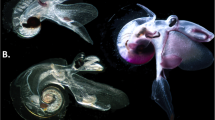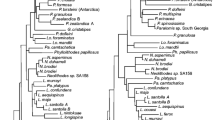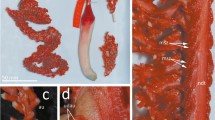Abstract
Portions of the mitochondrial genome (ca. 4 kb), encoding three protein-coding (COI, ND4L, ND6) and two ribosomal RNA (srRNA, lrRNA) genes, were sequenced for all six currently recognized species, plus one form, of the pelagic calanoid copepod genus Neocalanus. In Neocalanus gracilis, the ND6 gene was not found in the sequenced portion of the mitochondrial genome. Unambiguously aligned sequences were subjected to Bayesian, maximum-likelihood, maximum-parsimony, and neighbor-joining analyses using Eucalanus bungii as an outgroup. The resultant tree topologies from these four methods were congruent, robust, and all nodes were supported by high bootstrap values and posterior probabilities of 92–100%. Two tropical and subtropical species (N. gracilis and N. robustior) occupied the most basal position, and a subantarctic (N. tonsus) and three subarctic Pacific species (N. cristatus, N. plumchrus, and N. flemingeri) diverged subsequently. Transequatorial dispersal of the ancestral population during glaciations is suggested for this pattern of speciation, in which sister clades exhibited antitropical distributions. Although the area of ocean is much broader in the subantarctic than the subarctic Pacific, a higher number of species occur in the subarctic Pacific (three) than the subantarctic (one). The possibility that marginal seas, such as Japan Sea and Okhotsk Sea, function as natal areas for the divergence of species is discussed.




Similar content being viewed by others
References
Bradford JM (1988) Review of the taxonomy of the Calanidae (Copepoda) and the limits of the genus Calanus. Hydrobiologia 167/168:73–81
Bradford JM, Jillett JB (1974) A revision of generic definitions in the Calanidae (Copepoda, Calanoida). Crustaceana 27:5–16
Brodsky KA (1972) Phylogeny of the family Calanidae (Copepoda) on the basis of a comparative morphological analysis of its characters. Issled Fauny Morej 12:1–127 (English translation, Israel Program for Science Translations 1975)
Bucklin A, Frost BW, Bradford-Grieve J, Allen LD, Copley NJ (2003) Molecular systematic and phylogenetic assessment of 34 calanoid copepod species of the Calanidae and Clausocalanidae. Mar Biol 142:333–343
Burridge CP (2002) Antitropicality of Pacific fishes: molecular insights. Environ Biol Fish 65:151–164
Burridge CP, White RWG (2000) Molecular phylogeny of the antitropical subgenus Goniistius (Perciformes : Cheilodactylidae : Cheilodactylus): evidence for multiple transequatorial divergences and non-monophyly. Biol J Linn Soc 70:435–458
Campbell MH (1934) The life history and postembryonic development of the copepods, Calanus tonsus Brady and Euchaeta japonica Marukawa. J Biol Bd Can 1:1–65
Cheng S, Chang SY, Gravitt P, Respess R (1994) Long PCR. Nature 369:684–685
Conover RJ (1988) Comparative life histories in the genera Calanus and Neocalanus in high latitudes of the northern hemisphere. Hydrobiologia 167/168:127–142
Dunbar MJ (1979) The relation between the oceans. In: van der Spoel S, Pierrot-Bults AC (eds) Zoogeography and diversity of plankton. Halsted Press, New York, pp 112–125
Fulton J (1973) Some aspects of the life history of Calanus plumchrus in the Strait of Georgia. J Fish Res Bd Can 30:811–815
Heinrich AK (1962) The life histories of plankton animals and seasonal cycles of plankton communities in the oceans. J Cons Cons Int Explor Mer 27:15–24
Huelsenbeck JP, Ronquist F (2001) MrBAYES: Bayesian inference of phylogenetic trees. Bioinformatics 17:754–755
Klein Breteler WCM, Schogt N, Gonzalez SR (1990) On the role of food quality in grazing and development of life stages, and genetic change of body size during cultivation of pelagic copepods. J Exp Mar Biol Ecol 135:177–189
Kobari T, Ikeda T (1999) Vertical distribution, population structure and life cycle of Neocalanus cristatus (Crustacea: Copepoda) in the Oyashio region, with notes on its regional variations. Mar Biol 134:683–696
Kobari T, Ikeda T (2001a) Life cycle of Neocalanus flemingeri (Crustacea: Copepoda) in the Oyashio region, western subarctic Pacific, with notes on its regional variations. Mar Ecol Prog Ser 209:243–255
Kobari T, Ikeda T (2001b) Ontogenetic vertical migration and life cycle of Neocalanus plumchrus (Crustacea: Copepoda) in the Oyashio region, with notes on regional variations in body sizes. J Plankton Res 23:287–302
Lavrov DV, Boore JL, Brown WM (2000) The complete mitochondrial DNA sequence of the horseshoe crab Limulus polyphemus. Mol Biol Evol 17:813–824
Löytynoja A, Milinkovitch MC (2003) A hidden Markov model for progressive multiple alignment. Bioinformatics 19:1505–1513
Machida RJ, Miya MU, Nishida M, Nishida S (2002) Complete mitochondrial DNA sequence of Tigriopus japonicus (Crustacea: Copepoda). Mar Biotech 4:406–417
Machida RJ, Miya MU, Nishida M, Nishida S (2004) Large-scale gene rearrangements in the mitochondrial genomes of two calanoid copepods Eucalanus bungii and Neocalanus cristatus (Crustacea), with notes on new versatile primers for the srRNA and COI genes. Gene 332:71–78
Maddison DR, Maddison WP (2000) MacClade 4: analysis of phylogeny and character evolution. Sinauer Associates, Sunderland
Miller CB (1988) Neocalanus flemingeri, a new species of Calanidae (Copepoda: Calanoida) from the subarctic Pacific Ocean, with a comparative redescription of Neocalanus plumchrus (Marukawa) 1921. Prog Oceanogra 20:223–273
Miller CB, Clemons MJ (1988) Revised life history analysis for large grazing copepods in the subarctic Pacific Ocean. Prog Oceanogra 20:293–313
Miller CB, Frost BW, Batchelder HP, Clemons MJ, Conway RE (1984) Life histories of large, grazing copepods in a subarctic ocean gyre: Neocalanus plumchrus, Neocalanus cristatus, and Eucalanus bungii in the Northeast Pacific. Prog Oceanogra 13:201–243
Miller CB, Terazaki M (1989) The life histories of Neocalanus flemingeri and Neocalanus plumchrus in the Sea of Japan. Bull Plankton Soc Japan 36:27–41
Miller KJ, Bradford-Grieve JM, Jillett JB (1999) Genetic relationship between winter deep-dwelling and spring surface-dwelling female Neocalanus tonsus in the Southern Ocean. Mar Biol 134:99–106
Mullin MM, Evans PM (1976) Distribution, morphometry, and seasonal biology of the planktonic copepods Neocalanus robustior and Neocalanus gracilis in the Pacific Ocean. Pacific Sci 30:119–130
Nylander JAA (2004) MrModeltest 2.0. Program distributed by the author. Evolutionary Biology Centre, Uppsala University
Reid JL, Brinton E, Fleminger A, Venrick EL, McGowan JA (1978) Ocean circulation and marine life. In: Charnock H, Deacon G (eds) Advances in oceanography. Plenum, New York
Saito H, Tsuda A (2000) Egg production and early development of large subarctic copepods Neocalanus cristatus, N. plumchrus and N. flemingeri. Deep Sea Res Part I 47:2141–2158
Sewell RBS (1947) The free-swimming planktonic Copepoda. Systematic account. Scientific reports of the John Murray Expedition 1933–1934, vol 8, pp 1–303
Swofford DL (2002) PAUP*. Phylogenetic analysis using parsimony (*and other methods), version 4. Sinauer Associates, Massachusetts
Taniguchi M, Kanehisa T, Sawabe T, Christen R, Ikeda T (2004) Molecular phylogeny of Neocalanus copepods in the subarctic Pacific Ocean, with notes on non-geographical genetic variations for Neocalanus cristatus. J Plankton Res 26:1249–1255
Tsuda A, Saito H, Kasai H (1999) Life histories of Neocalanus flemingeri and Neocalanus plumchrus (Calanoida: Copepoda) in the western subarctic Pacific. Mar Biol 135:533–544
Tsuda A, Saito H, Kasai H (2001a) Geographical variation of body size of Neocalanus cristatus, N. plumchrus and N. flemingeri in the subarctic Pacific and its marginal seas: implication for the origin of large form of N. flemingeri in the Oyashio area. J Oceanogr 57:341–352
Tsuda A, Saito H, Kasai H (2001b) Life history strategies of subarctic copepods Neocalanus flemingeri and N. plumchrus, especially concerning lipid accumulation patterns. Plankton Biol Ecol 48:52–58
Valverde JR, Batuecas B, Moratilla C, Marco R, Garesse R (1994) The complete mitochondrial DNA sequence of the crustacean Artemia franciscana. J Mol Evol 39:400–408
van der Spoel S, Pierrot-Bults AC (1979) Zoogeography of the Pacific Ocean. In: van der Spoel S, Pierrot-Bults AC (eds) Zoogeography and diversity of plankton. Halsted Press, New York, pp 293–327
Vervoort W (1946) Biological results of the Snellius Expedition. The bathypelagic Copepoda Calanoida of the Snellius Expedition. I. Families Calanidae, Eucalanidae, Paracalanidae, and Pseudocalanidae. Temminckia 8:1–181
Vervoort W (1957) Copepods from Antarctic and Sub-antarctic plankton samples. Rep BANZ Antarct Res Exped B3:1–160
Yang ZB (1994) Estimating the pattern of nucleotide substitution. J Mol Evol 39:105–111
Acknowledgements
This study could not have been possible without the generous donations of samples, for which we sincerely thank the following colleagues: E. Goetze, K. Hashizume, J. Nishikawa, and A. Tsuda. We express our thanks to the captains and crew members of the R.V. Hakuho Maru and Tansei Maru for their cooperation at sea. This study is a contribution from the Census of Marine Zooplankton (CMarZ), an ocean realm field project of the Census of Marine Life. Funding for this study was provided by a Grant-in-Aid for Creative Basic Research no.12NP0201 from the Ministry of Culture, Sports, Science and Technology of Japan, and the Alfred P. Sloan Foundation. The experiments comply with the current laws of the country in which the experiments were performed.
Author information
Authors and Affiliations
Corresponding author
Additional information
Communicated by T. Ikeda, Hakodate
Rights and permissions
About this article
Cite this article
Machida, R.J., Miya, M.U., Nishida, M. et al. Molecular phylogeny and evolution of the pelagic copepod genus Neocalanus (Crustacea: Copepoda). Marine Biology 148, 1071–1079 (2006). https://doi.org/10.1007/s00227-005-0140-0
Received:
Accepted:
Published:
Issue Date:
DOI: https://doi.org/10.1007/s00227-005-0140-0




